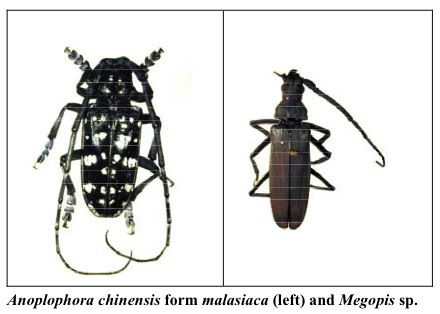PESTS AND DISEASES OF FORESTRY IN NEW ZEALAND
Exotic longhorn beetles found at Tauranga
Scion is the leading provider of forest-related knowledge in New Zealand
Formerly known as the Forest Research Institute, Scion has been a leader in research relating to forest health for over 50 years. The Rotorua-based Crown Research Institute continues to provide science that will protect all forests from damage caused by insect pests, pathogens and weeds. The information presented below arises from these research activities.
From Forest Health News 132, August 2003.
 On Tuesday 15 July 2003, a live adult male citrus longhorn beetle (Anoplophora chinensis form malasiaca ) was found by a staff member on a concrete slab outside a warehouse in Tauranga. The specimen was collected on the following day by David Moore (Environment Bay of Plenty) and delivered on 17 July to Roger Crabtree (Forest Research), who immediately notified the Ministry of Agriculture and Forestry (MAF). On 18 July a site investigation was conducted by an Incursion Investigator from the MAF National Plant Pest Reference Laboratory (NPPRL) accompanied by a MAF Quarantine Service officer. This was followed by a second visit on 24 July.
On Tuesday 15 July 2003, a live adult male citrus longhorn beetle (Anoplophora chinensis form malasiaca ) was found by a staff member on a concrete slab outside a warehouse in Tauranga. The specimen was collected on the following day by David Moore (Environment Bay of Plenty) and delivered on 17 July to Roger Crabtree (Forest Research), who immediately notified the Ministry of Agriculture and Forestry (MAF). On 18 July a site investigation was conducted by an Incursion Investigator from the MAF National Plant Pest Reference Laboratory (NPPRL) accompanied by a MAF Quarantine Service officer. This was followed by a second visit on 24 July.
During the examination a range of exotic organisms was collected from five wooden reels of wire rope from China, which had been present on the site since November 2002. These included a cast larval skin of the citrus longhorn beetle, an adult and larvae of the thin-winged longhorn beetle (Megopis sinica), a number of darkling beetles (Plesiophthalmus sp.), and various live fungi. Longhorn beetle frass and workings were present in all five reels, the damage on two of them being recent. Three exit holes were found on one reel, two in a section of wood that yielded two Megopis sp. larvae, and the third in another panel where the A. chinensis cast larval skin was found. Similar damage with no exit holes was found in three more wooden reels from the same consignment, two in Auckland, and one in Nelson, and two other reels are being traced. All reels found to date have been fumigated or incinerated. The discovery of these insects is of concern, since the longhorn beetles in particular have the potential to attack living trees.
Inquiries have revealed that the wooden reels were not treated at the border because there was no indication of a need for biosecurity clearance, since they had not been declared in the importing manifest. This is being followed up.
Mark Bullians and Alan Flynn, MAF
This information is intended for general interest only. It is not intended to be a substitute for specific specialist advice on any matter and should not be relied on for that purpose. Scion will not be liable for any direct, indirect, incidental, special, consequential or exemplary damages, loss of profits, or any other intangible losses that result from using the information provided on this site.
(Scion is the trading name of the New Zealand Forest Research Institute Limited.)



